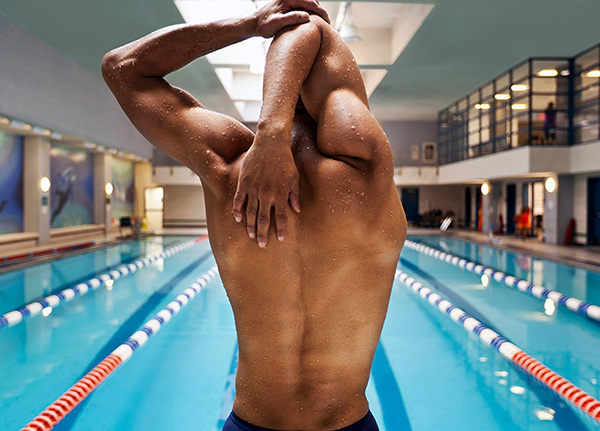Do you want to learn butterfly swimming but don’t know where to start? In this article, Swim Time Log will give you a step-by-step guide to butterfly swimming for beginners. Let’s learn how to use correct technique and important notes to develop effective butterfly swimming skills.
Introduction to the Butterfly Stroke: What Makes it Unique?
Butterfly Stroke Swimming
While other swimming styles such as backstroke, breaststroke, and front crawl are suitable for beginners, butterfly swimming is more difficult, requiring good techniques and physical strength.
Furthermore, butterfly swimming is the newest swimming style introduced into competitive swimming. This swimming style appeared in 1933, originating from the familiar breaststroke swimming style.
Butterfly swimming possesses a higher maximum swimming speed than front crawl swimming. Swimming with simultaneous combined movements of both hands when pulling and pushing water. So butterfly swimming becomes more unique than regular swimming
Step 1: Warm Up and Stretching Exercises
Warm Up
Warm-up and stretching exercises are crucial when swimming to prevent injuries and enhance performance. Before diving into the water, it’s essential to engage in a proper warm-up routine that includes dynamic movements like arm swings, leg swings, and torso rotations. These exercises increase blood flow, loosen up muscles, and improve flexibility.
Additionally, incorporating stretching exercises such as shoulder stretches, quad stretches, and hamstring stretches can further improve the range of motion and reduce the risk of strains. By prioritizing warm-up and stretching exercises, swimmers can optimize their workouts and enjoy a safer and more effective swimming experience.
Step 2: Body Position and Breathing Techniques
Aligning your body position for Butterfly Stroke
When swimming butterfly, proper body position and breathing technique play a crucial role in optimizing performance. Maintaining a horizontal body position helps reduce drag and allows for efficient movement through the water. Additionally, mastering the timing of breaths is essential.
By taking quick breaths during the arm recovery phase, swimmers can minimize disruptions to their stroke rhythm and maximize oxygen intake. Implementing correct body position and breathing techniques enhances the overall efficiency and effectiveness of the butterfly stroke, leading to improved results in the pool
Step 3: Arm Movement and Timing
The Right Arm Movement
Arm movements and timing play a crucial role in butterfly swimming. The coordinated motion of the arms is essential for generating power and maintaining a streamlined body position in the water. In butterfly, the arms move in a simultaneous, symmetrical manner, sweeping out of the water and then propelling forward with forceful downward strokes.
Proper timing is key to optimize propulsion and minimize drag. Understanding the correct technique for arm movements and timing in butterfly swimming can greatly enhance performance and efficiency in the water. Mastering these aspects can lead to smoother and more powerful strokes, enabling swimmers to excel in this challenging and dynamic swimming style.
Step 4: Leg Kick Technique
The Dolphin Kick
Kicking technique when swimming butterfly is crucial for efficient propulsion and maintaining a streamlined body position in the water. Proper coordination between the dolphin kick of the legs and the undulating movement of the upper body is essential. By mastering the correct timing, amplitude, and rhythm of the kick, swimmers can maximize their speed and minimize drag, leading to improved performance. Understanding and practicing the fundamental principles of butterfly kicking can greatly enhance your swimming abilities and help you excel in this demanding stroke.
Step 5: Putting it All Together and Practicing the Butterfly Stroke
When practicing swimming, performing the correct Butterfly Stroke technique is important to achieve maximum performance. The butterfly stroke requires synchronization between legs and arms, and flexibility of the body. By practicing regularly and focusing on the key elements of this technique, you can improve your speed and power in the butterfly stroke. Try practicing the butterfly stroke and experience the excitement and fun of this sport.
Mastering the Butterfly Stroke Takes Practice and Persistence
Mastering the butterfly stroke requires dedicated practice and unwavering persistence. This challenging swimming technique demands precision and strength. By embracing a consistent training regimen and maintaining a determined mindset, individuals can conquer the complexities of the butterfly stroke. Unlock your potential in the water through perseverance and discipline, and witness the transformative power of practice.
Read more:
- Mastering Breath Control in Butterfly Swimming: Techniques, Tips, and Benefits
- Front Crawl vs. Butterfly Stroke: A Comparative Analysis
- Mastering Freestyle Swimming Breathing





AUTHOR
Sang Nguyen
Sang Nguyen is a former national swimmer for Vietnam who has transitioned into coaching. With a passion for fostering a healthy swimming community and connecting like-minded individuals,......Read More
BLOG
Maybe You Are Interested
Nutrition for Swimmers Guide: Maximizing Performance
Swimming demands not only physical prowess but also a strategic nutritional approach to maximize performance....
Crafting a Nutrition Plan for Competitive Swimmers
In the competitive world of swimming, nutrition plays a pivotal role in an athlete’s performance...
A Comprehensive Guide to Maximum Performance Nutrition for Swimmers
Swimming is not just about technique and training; nutrition plays a pivotal role in a...
Essential Swim Nutrition Tips for Peak Performance
Swimming is a highly demanding sport, requiring a combination of technique, strength, and endurance. But...
Expert Sports Nutrition Advice for Swimmers
In the competitive world of swimming, nutrition and training are as crucial as the technique...
The Synergy of Swimming and Nutrition: Balancing Intake for Optimal Water Performance
The Synergy of Swimming and Nutrition: Balancing Intake for Optimal Water Performance dives into the...